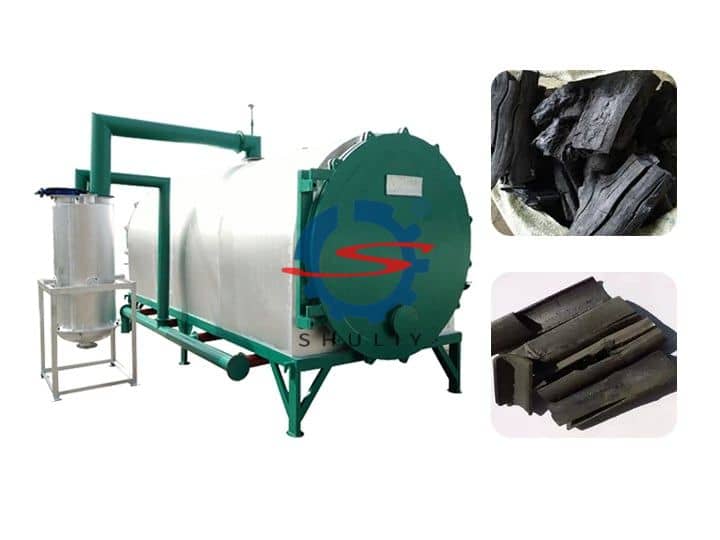Carbonization Furnace – the Complete Guide for Your Business
A carbonization furnace is a type of industrial furnace that is used to convert organic materials, such as wood, coal, rice husk, coconut, and biomass, into carbon-rich products, such as charcoal or coke. The process of carbonization involves heating the organic material in an oxygen-deprived environment, which causes the material to break down and release volatile compounds. The remaining solid material is composed mostly of carbon and is known as the char. The char is then further processed to create products such as activated carbon, which is used in a variety of applications, including water treatment, air purification, and chemical processing. Carbonization furnaces are often used in the production of steel, where they are used to produce coke, which is used as a fuel in the blast furnace process. Carbonization furnaces can be fueled by a variety of sources, including wood, coal, and natural gas.

What is carbonization process?
Carbonization is the process of converting organic matter into carbon or a carbon-rich material through pyrolysis, which is the thermal decomposition of materials at high temperatures in the absence of oxygen. Carbonization can occur naturally, through processes such as the formation of coal from plant material over millions of years, or it can be done artificially, by heating organic matter in a controlled environment.
During the carbonization process, the organic matter is heated to temperatures ranging from 350 to 1000°C, depending on the specific conditions and the desired end product. As the material is heated, it undergoes a series of chemical reactions that break down the organic molecules into simpler substances, releasing gases and leaving behind a solid residue of carbon.
There are several applications for carbonization, including the production of charcoal, the production of activated carbon, and the production of carbon black. Carbonization can also be used to stabilize and preserve organic materials, such as wood or bone, by removing the volatile components and reducing the risk of decay.
How does a carbonization furnace work?
Carbonization furnaces are a type of industrial equipment used to convert organic materials into carbon or a carbon-rich material through the process of pyrolysis. There are various designs and configurations of carbonization furnaces, but they generally consist of the following components:
A heating chamber: This is the main part of the furnace where the organic material is heated to the desired temperature. The heating chamber is typically lined with refractory materials, such as bricks or ceramic, to prevent heat loss and to protect the furnace structure from high temperatures.
A heating system: This is the source of heat for the furnace, which can be powered by a variety of energy sources, such as electricity, natural gas, coal, or biomass. The heating system is typically controlled by a thermostat or other temperature control device to ensure that the organic material is heated to the desired temperature.
A feed system: This is a mechanism for introducing the organic material into the heating chamber, such as a conveyor belt or a hopper. The feed system is designed to evenly distribute the material across the heating chamber and to maintain a constant flow of material into the furnace.
A gas removal system: During the carbonization process, a variety of gases are released from the organic material as it is heated. These gases must be removed from the heating chamber to prevent the risk of explosion or fire. The gas removal system typically consists of a series of pipes or vents that are connected to the heating chamber and lead to a gas scrubber or other treatment system.
A cooling system: After the carbonization process is complete, the carbonized material must be cooled before it can be handled or processed further. The cooling system is designed to rapidly lower the temperature of the material, typically through the use of air or water circulation.
What is carbonization of biomass?
Carbonization of biomass refers to the process of converting organic materials, such as wood, grasses, and agricultural waste, into carbon-rich products through the application of heat and pressure in an oxygen-deprived environment. The process of carbonization is also known as pyrolysis.
During the carbonization process, the biomass is subjected to high temperatures (usually in the range of 400-700°C) in the absence of oxygen. As the biomass is heated, it begins to break down and release volatile compounds, such as gases, liquids, and tars. The remaining solid material is composed mostly of carbon and is known as the char. The char can then be further processed to create a variety of products, such as activated carbon, biochar, and wood vinegar.
Carbonization of biomass is an important process for the production of renewable energy, as it allows the conversion of biomass into a form that can be used as a fuel. Carbonization of biomass can also help to reduce greenhouse gas emissions by providing an alternative to fossil fuels, which are a major contributor to climate change. Additionally, carbonization of biomass can be used to produce a variety of industrial and consumer products, such as activated carbon, which is used in water treatment and air purification.
What is carbonization of charcoal?
Carbonization of charcoal refers to the process of converting wood or other organic materials into charcoal through the application of heat and pressure in an oxygen-deprived environment. The process of carbonization is also known as pyrolysis.
During the carbonization process, the wood or other organic material is subjected to high temperatures (usually in the range of 400-700°C) in the absence of oxygen. As the material is heated, it begins to break down and release volatile compounds, such as gases, liquids, and tars. The remaining solid material is composed mostly of carbon and is known as the char. The char can then be further processed to create a variety of products, such as activated carbon, which is used in water treatment and air purification.
Charcoal is a versatile material that has a wide range of uses, including as fuel for cooking, grilling, and industrial processes. It is also used in the production of steel, where it is used as fuel in the blast furnace process. Carbonization of charcoal is an important process for the production of renewable energy, as it allows the conversion of biomass into a form that can be used as a fuel. Carbonization of charcoal can also help to reduce greenhouse gas emissions by providing an alternative to fossil fuels, which are a major contributor to climate change.
Why is it called carbonization?
The process of carbonization is called carbonization because it results in the production of a carbon-rich material, known as char. Carbonization involves the application of heat and pressure in an oxygen-deprived environment to organic materials, such as wood, coal, and biomass. As the material is heated, it begins to break down and release volatile compounds, such as gases, liquids, and tars. The remaining solid material is composed mostly of carbon and is known as the char.
The term “carbonization” is derived from the Latin word “carbo,” which means “coal.” The process of carbonization has been used for centuries to produce coal and coke from various types of organic materials. Today, carbonization is also used to produce a variety of other products, such as activated carbon, which is used in water treatment and air purification. Carbonization is an important process for the production of renewable energy, as it allows the conversion of biomass into a form that can be used as a fuel. Carbonization can also help to reduce greenhouse gas emissions by providing an alternative to fossil fuels, which are a major contributor to climate change.
What is the advantages of carbonization?
There are several advantages to the process of carbonization, including:
Production of renewable energy: Carbonization allows the conversion of biomass into a form that can be used as a fuel. This provides an alternative to fossil fuels and can help to reduce greenhouse gas emissions.
Production of industrial and consumer products: Carbonization can be used to produce a variety of products, including activated carbon, which is used in water treatment and air purification, and biochar, which is used as a soil amendment.
Reduction of waste: Carbonization can be used to convert waste materials, such as agricultural waste and wood chips, into valuable products. This helps to reduce waste and can also help to reduce the need for landfill disposal.
Increased efficiency: Carbonization can be more efficient than other methods of converting biomass into fuel, as it allows for the production of a higher-energy density fuel.
Lower cost: Carbonization can be a cost-effective way to produce renewable energy and industrial products.
Environmental benefits: Carbonization can help to reduce greenhouse gas emissions and can also improve soil health when biochar is used as a soil amendment.
What is the disadvantages of carbonization?
There are several potential disadvantages to the process of carbonization, including:
Emissions: The carbonization process can produce emissions, including carbon dioxide and other greenhouse gases. These emissions can contribute to climate change if they are not properly controlled.
Pollution: The carbonization process can also produce other types of pollution, such as particulate matter and volatile organic compounds, which can have negative impacts on air quality.
Waste products: Carbonization produces a variety of waste products, including tars and liquids, which must be disposed of in an environmentally responsible manner.
High temperatures: Carbonization requires high temperatures, which can be difficult to achieve and maintain. This can increase the cost and complexity of the process.
Limited feedstocks: Carbonization is typically limited to certain types of feedstocks, such as wood and biomass, and may not be suitable for all types of organic materials.
Capital intensive: Carbonization equipment can be expensive to purchase and maintain, which can make the process cost-prohibitive for some companies.
About us
Shuliy group is a professional carbonization furnace equipment factory. We provide a full range of carbonization furnaces to meet your specific requirements. Our products cover rotary carbonization furnace, horizontal carbonization furnace, vertical carbonization furnace, and biomass carbonization furnace. If you any interest, please get in touch with us for more useful information.
